Yellampalli S. (ed.) Carbon Nanotubes - Synthesis, Characterization, Applications
Подождите немного. Документ загружается.


Reinforced Thermoplastic Natural Rubber (TPNR) Composites
with Different Types of Carbon Nanotubes (MWNTS)
447
3. Results and discussion
3.1 Tensile properties
3.1.1 Tensile strength
The tensile strength of TPNR reinforced with two types of MWNTs of different percentages
(1%, 3%, 5% and 7%) is shown in Figure 1. Generally, both MWNTs exhibited an increasing
trend up to 3wt% content. Further increments in MWNTs content decreased the tensile
strength compared to the optimum filler loading.
11
12
13
14
15
16
17
18
19
0% 1% 3% 5% 7%
wt % of M WN Ts
Tensile strength (MPa)
TPNR TPNR+MWNTs 1 TPNR+MWNTs 2
Fig. 1. Tensile strength of TPNR reinforced with two types of MWNTs
From Figure 1,TPNR with MWNTs 1 and MWNTs 2 have optimum results at 3 % wt, which,
compared with TPNR, increased by 23% and 39%, respectively. The tensile strength
increased radically as the amount of MWNTs concentration increased. The mechanical
performance, such as tensile properties, strongly depends on several factors such as the
properties of the filler reinforcement and matrix, filler content, filler length, filler orientation,
and processing method and condition. The improvement in the tensile strength may be
caused by the good dispersion of MWNTs in the TPNR matrix, which leads to a strong
interaction between the TPNR matrix and MWNTs. These well-dispersed MWNTs may
have the effect of physically crosslinking points, thus, increasing the tensile strength (Bin et
al., 2006).
A good interface between the CNTs and the TPNR is very important for a material to stand
the stress. Under load, the matrix distributes the force to the CNTs, which carry most of the
applied load. When the content of MWNTs is higher, the MWNTs cannot disperse
adequately in the TPNR matrix and agglomerate to form a big cluster. This is because of the
huge surface energy of MWNTs as well as the weak interfacial interaction between MWNTs
and TPNR, which leads to inhomogeneous dispersion in the polymer matrix and negative
effects on the properties of the resulting composites that causes a decrease in the tensile
strength (Sang et al., 2007).
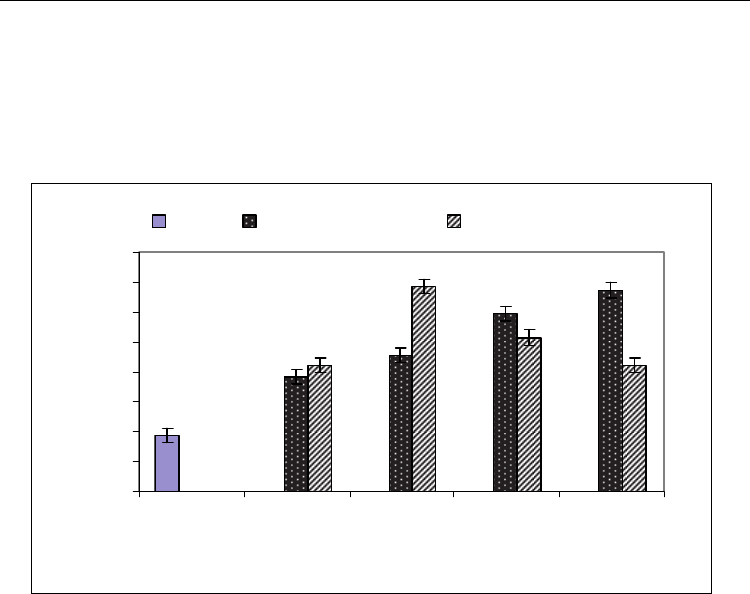
Carbon Nanotubes - Synthesis, Characterization, Applications
448
3.1.2 Young's modulus
Figure 5.2 shows the effect of filler content on the tensile modulus of TPNR reinforced by
two types of MWNTs. The same trend as for the tensile strength in Figure .1 was observed
for the tensile modulus of MWNTs 2, however, for MWNTs 1 it was different. Figure 2
clearly shows that the presence of MWNTs has significantly improved the tensile modulus
of the TPNR.
300
320
340
360
380
400
420
440
460
0% 1% 3% 5% 7%
wt % of M WNTs
Young's modulus (MPa)
TPNR TPNR+MWNTs 1 TPNR+MWNTs 2
Fig. 2. Young's modulus of TPNR reinforced with two types of MWNTs.
The remarkable increase of Young's modulus with MWNTs 1 content shows a greater
improvement than that seen in the tensile strength at high content, which indicates that the
Young’s modulus increases with an increase in the amount of the MWNTs 1. At 1 wt% of
MWNTs the Young’s modulus is increased by 11% compared to TPNR. At 3 wt% of
MWNTs the increase in the Young’s Modulus is about 16%. Further addition of MWNTs
from 5 to 7 wt% increased the Young modulus by about 24% and 29%, respectively. The
improvement of modulus is due to the high modulus of MWNTs (Treacy et al., 1996).
As depicted in Figure 2 the Young's modulus of MWNTs 2 increased with the increase in the
amount of MWNTs. The maximum result was achieved at 3% wt, with an increase of about
30%, which was due to the good dispersion of nanotubes displaying perfect stress transfer
(Potschke et al., 2002). As explained before, a reduction in performance occurred at higher
filler contents. Initially it increases with filler content and then decreases when exceeding
the filler loading limit due to the diminishing interfacial filler-polymer adhesion. It is
assumed that aggregates of nanotube ropes effectively reduce the aspect/ratio
(length/diameter) of the reinforcement (Lopez Manchado et al., 2005).
3.1.3 Elongation at break
The elongation at the break of TPNR with two types of MWNTs is shown in Figure 3. For
MWNTs 1, the elongation at break increased with the increase in the amount of MWNTs, at
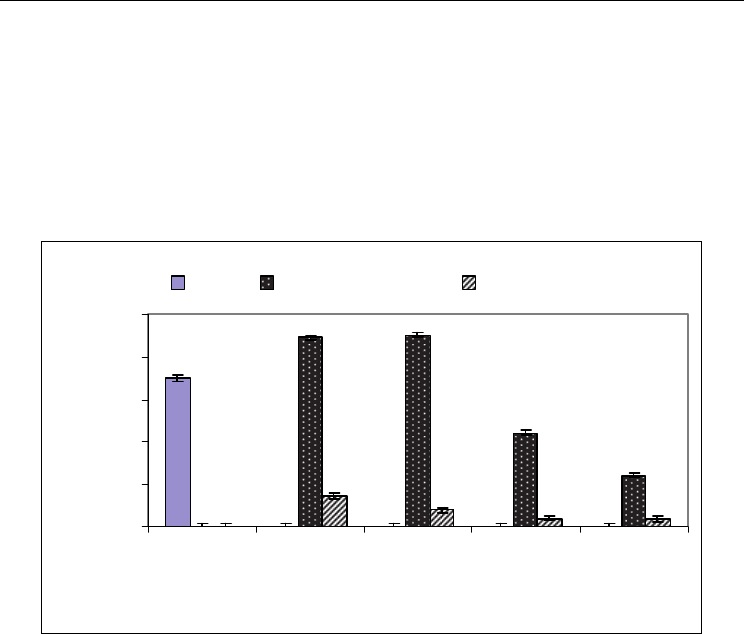
Reinforced Thermoplastic Natural Rubber (TPNR) Composites
with Different Types of Carbon Nanotubes (MWNTS)
449
3% wt the result is the optimum, which increased 29% compared with TPNR. However, the
elongation at break of MWNTs 2 decreased with the increase in the amount of MWNTs.
It can be deduced that the reinforcing effect of MWNTs is very marked. As the MWNTs
content in the TPNR increases, the stress level gradually increases but at the same time the
strain of the nanocomposites decreased. This is because the MWNTs included in the TPNR
matrix behave like physical crosslinking points and restrict the movement of polymer chains
(Sang et al., 2007). This shows that the inclusion of MWNTs makes the TPNR stronger but
more brittle.
0
100
200
300
400
500
0% 1% 3% 5% 7%
wt % o f M WN Ts
Elongation at break (%
)
TPNR TPNR+MWNTs 1 TPNR+MWNTs 2
Fig. 3. Elongations at break of TPNR reinforced with two types of MWNTs.
3.2 Impact strength
The effect of filler loading on the impact strength of TPNR/MWNTs nanocomposites
(MWNTs 1 and 2) is given in Figure 4. It shows that incorporation of MWNTs into TPNR
considerably affects the impact strength of TPNR nanocomposites.
The results exhibited better impact strength for MWNT 1 and MWNT 2 at 5 wt% with an
increase of almost 70 % and 74%, respectively. This is due to the better dispersion of carbon
nanotubes in the matrix, which generated a significant toughening effect on the
TPNR/MWNTs nanocomposite. However, when the load is transferred to the physical
network between the matrix and the filler, the debonding of the chain segments from the
filler surface facilitates the relaxation of the matrix entanglement structure, leading to higher
impact toughness.
The low impact energy was attributed to the filler content. This will reduce the ability of
reinforced composites to absorb energy during fracture propagation. However, in the case
of elastomer-toughened polymer, the presence of the elastomer basically produces stress
redistribution in the composite, which causes micro cracking or crazing at many sites,
thereby resulting in a more efficient energy dissipation mechanism (Canche-Escamilla et al.,
2002).
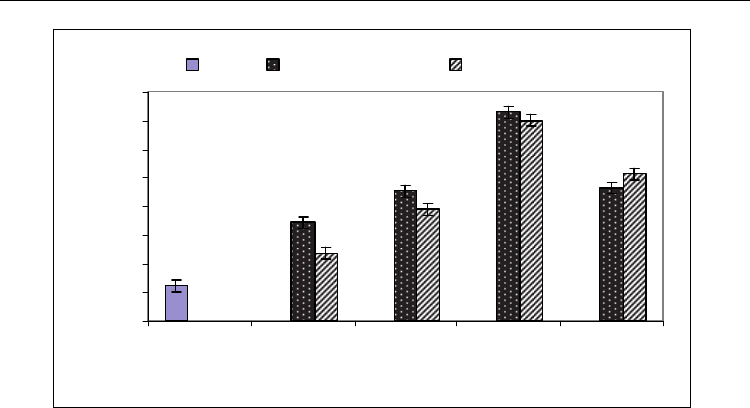
Carbon Nanotubes - Synthesis, Characterization, Applications
450
7
8
9
10
11
12
13
14
15
0% 1% 3% 5% 7%
Wt % of M WNTs
Impact strength (KJ/m^
2
)
TPNR TPNR+MWNTs 1 TPNR+MWNTs 2
Fig. 4. Impact strength of TPNR reinforced with two types of MWNTs.
Consequently, because of their higher surface energy and large aspect ratio, it will be
difficult for the nantubes to disperse in the TPNR when the MWNTs content is higher. This
will lead to less energy dissipating in the system due to the poor interfacial bonding and
induces micro spaces between the filler and polymer matrix. This causes micro-cracks when
impact occurs, which induces easy crack propagation. Therefore, the higher agglomeration
of MWNTs can cause the mechanical properties of the composites to deteriorate (Jianfeng
Shen et al., 2007).
3.3 Dynamic mechanical analysis
3.3.1 Storage modulus
Figure 5 and Figure 6 illustrate the storage modulus of TPNR reinforced with MWNTs 1 and
MWNTs 2. As illustrated in these Figures, the storage modulus of the nanocomposites
mainly depends on the filler content in the composite. Two consistent variations of the E’
with temperature are observed for all systems, which are a sharp drop around -50
o
C (±10
o
C)
and a reduction in the E’ drop rate with temperatures above 80
o
C. The first drop is related to
the glass transition region of compatibilised TPNR blends. The reduction in E’ is less severe
until the softening point or when the melt region is reached.
The storage modulus of neat TPNR and its nanocomposites decreased with the increasing
temperature, as expected. However the most characteristic difference is that the storage
modulus E' of TPNR/MWNTs 1 nanocomposites tends to increase with the increase in the
amount of MWNTs. This indicates the effectiveness of the MWNTs’ reinforcing effect. The
maximum values of storage modulus for the first type (MWNTs 1) were obtained at 1wt%
and 3wt%, however, for the second type (MWNT 2) it was obtained at 3wt% and 5wt%.
At the same time the storage modulus of two types of MWNTs, below T
g
, of TPNR/MWNTs
is higher compared with composites above T
g
. The stiffening effect is maximized at
temperatures below T
g
and becomes greatly reduced at temperatures above T
g
. Such a
phenomenon has also been observed in other well dispersed polymer composite systems
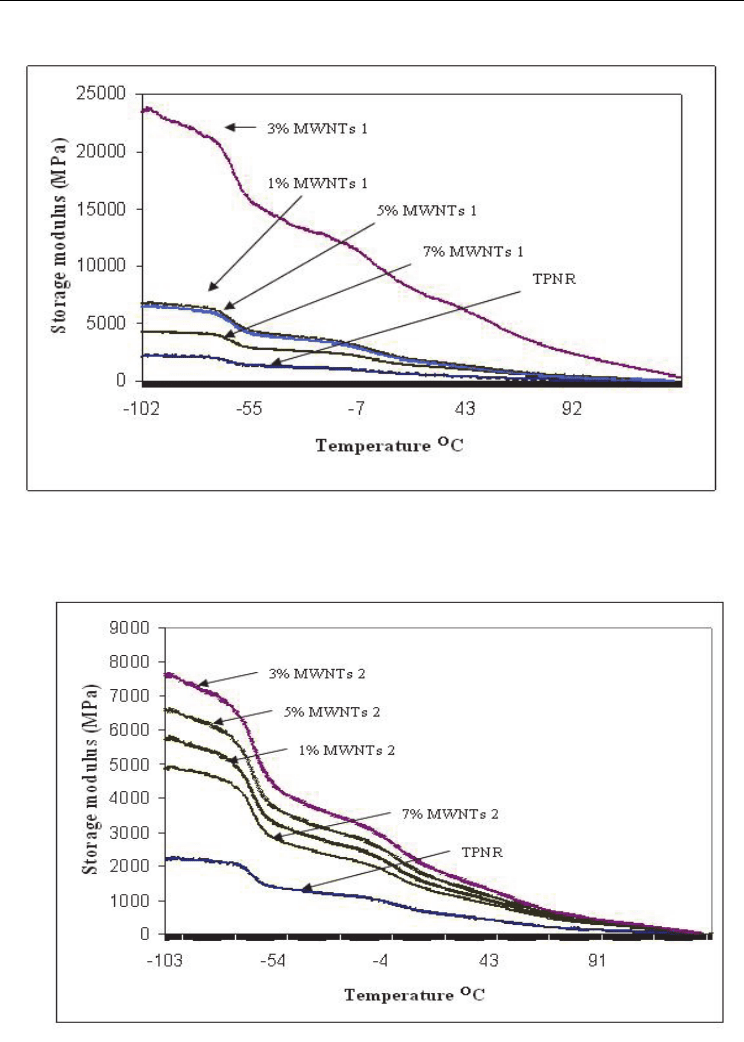
Reinforced Thermoplastic Natural Rubber (TPNR) Composites
with Different Types of Carbon Nanotubes (MWNTS)
451
Fig. 5. Storage modulus of TPNR and TPNR/MWNTs 1 nanocomposites.
Fig. 6. Storage modulus of TPNR and TPNR/MWNTs 2 nanocomposites.
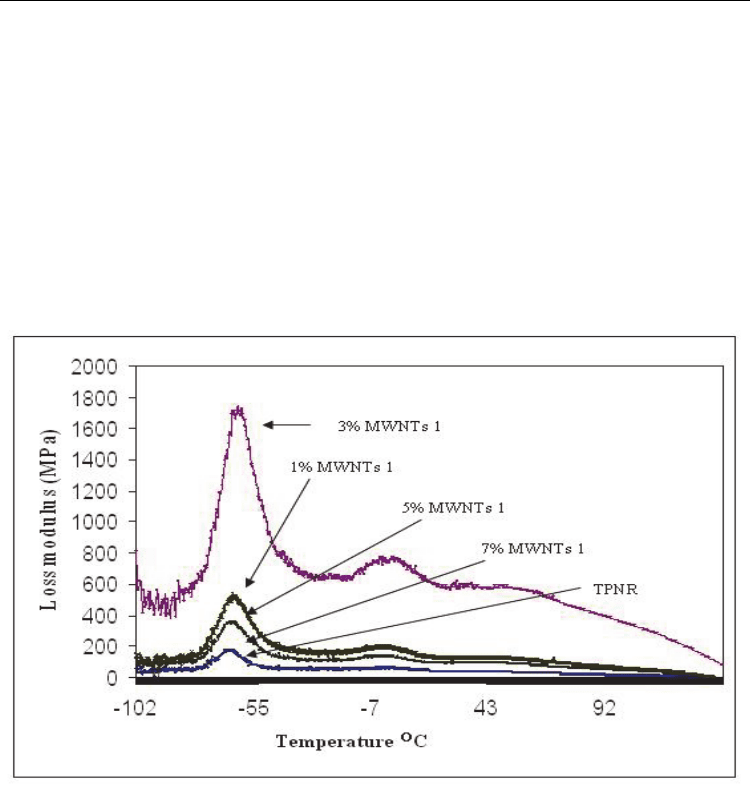
Carbon Nanotubes - Synthesis, Characterization, Applications
452
(Sue et al., 2004). The carbon nanofibers are effective at increasing the stiffness of the
prepared nanocomposites, even at relatively small nanofiber loadings. For 1% and 3% of
MWNTs this increase should be attributed to the finer dispersion of these nanotubes in the
TPNR matrix and the decreased size of the formed aggregates. After 3% of MWNTs 1 and
after 5% of MWNTs 2 the storage modulus decreased due to the agglomeration of nanotubes
inside the matrix.
3.3.2 Loss modulus
In addition, from Figure 7 and Figure 8, the loss modulus E'' of the composites is higher
than TPNR at 1% and 3% of MWNTs 1, and 3% and 5% of MWNTs 2, which is because the
nanotubes can be more uniformly dispersed in the matrix at this percentage of MWNTs.
Therefore, the interfacial area is larger and the interaction between the matrix and
nanotubes is stronger.
Fig. 7. Loss modulus of TPNR and TPNR/MWNTs 1 nanocomposites.
Since the value of E'' at lower temperatures has a great influence on the toughness of the
matrix, it is obvious that MWNTs contribute to the improvement of the toughness of the
composites. A mesophase is formed between the matrix and MWNTs. Therefore, when the
composites were subjected to external stress, the external energy was dissipated by the
friction between MWNTs-MWNTs and MWNTs-TPNR interaction through the mesophase.
However, after 3% of MWNTs 1 and 5% of MWNTs 2 the loss modulus E'' had decreased
due to agglomeration of MWNTs inside the matrix as mentioned before. Due to the
polymer-filler interaction, the adsorption of the polymer chains on the filler’s surface
reduces the mobility of the macromolecular segments. This transition zone surrounding the
nanoparticles exhibits a higher modulus, which gradually reduces with the increasing
distance from the filler surface (Wang, 1998).
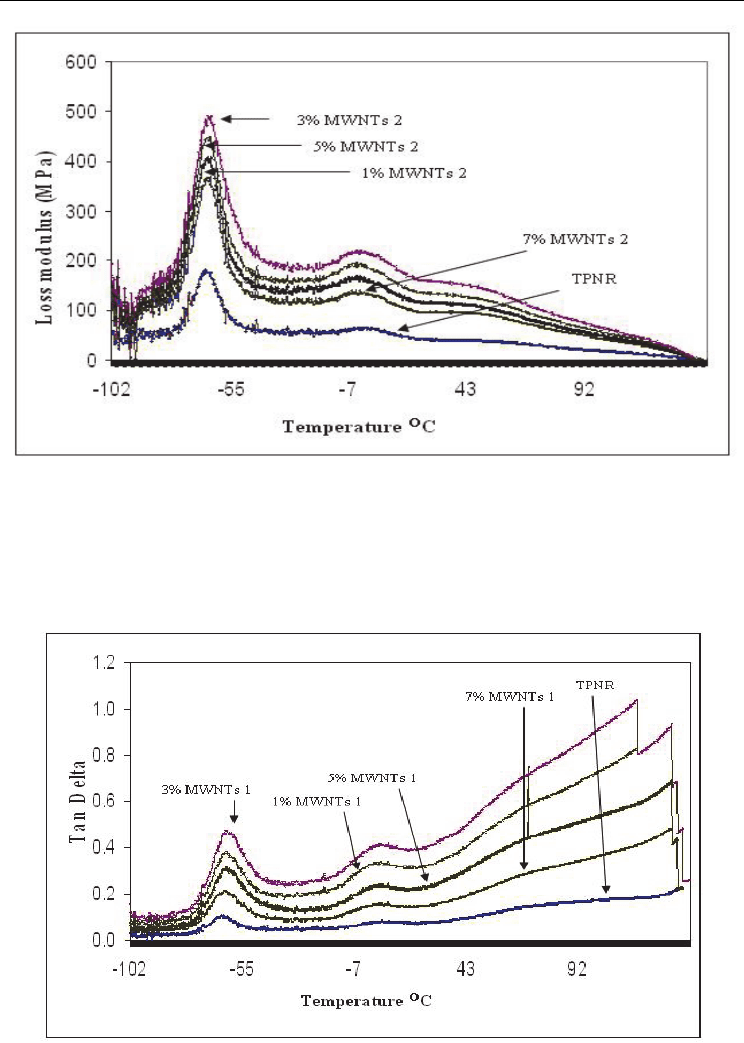
Reinforced Thermoplastic Natural Rubber (TPNR) Composites
with Different Types of Carbon Nanotubes (MWNTS)
453
Fig. 8. Loss modulus of TPNR and TPNR/MWNTs 2 nanocomposites.
3.3.3 Tan delta
The dynamic mechanical data shows that the glass transition temperature of the
TPNR/MWCNTs is affected by the addition of the different amounts of two types of
MWNTs, as depicted in Figure 9 and Figure 10.
Fig. 9. Tan delta of TPNR and TPNR/MWNTs 1 nanocomposites.
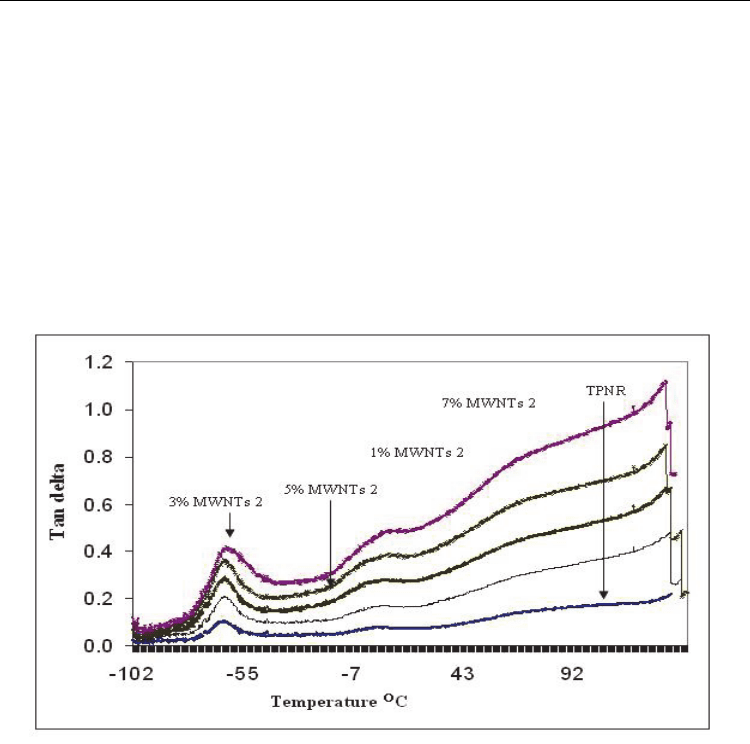
Carbon Nanotubes - Synthesis, Characterization, Applications
454
From the figures, the tan δ peak of the nanocomposites is higher than the corresponding
temperature of TPNR. As mentioned earlier, usually the T
g
of a polymeric matrix tends to
increase with the addition of carbon nanotubes. The rise in T
g
in any polymeric system is
associated with a restriction in molecular motion, reduction in free volume and/or a higher
degree of crosslinking due to the interactions between the polymer chains and the
nanoparticles, and the reduction of macromolecular chain mobility (Potschke et al., 2002).
With the high amount of MWNTs (after 3% of MWNTs 1 and 5% of MWNTs 2) the T
g
drops.
This maybe due to the phase separation/agglomeration of MWNTs, which allows the
macromolecules to move easily. When the content of MWNTs is higher, the MWNTs
congregate, possibly because the intrinsic van der Waals forces occurs, which leads to
bubbles and small aggregates. The conglomerations and matrix holes existing in the
network of MWNTs may perform as defects, which make the macromolecules move easily,
and the T
g
of the matrix is decreased.
Fig. 10. Tan delta of TPNR and TPNR/MWNTs 2 nanocomposites.
3.4 Thermal behavior of TPNR/MWNTS (Two Types OF MWNTS)
3.4.1 Thermal conductivity
To study the effect of MWNTs filler on thermal conductivity, the temperature was varied
from (30 – 150)
C. The temperature range was selected based on the melting point of
polypropylene (PP), since PP melts above 178 °C (Mustaffa, 1991). The carbon filler loading
was from 1%wt to 7%wt for two types of carbon nanotubes. Introducing MWNTs to TPNR
can significantly enhance the thermal conductivity of the TPNR matrix, as shown in Figure
11 and Figure 12.
As shown from the figures at 30°C the thermal conductivity of TPNR/MWNTs 1
composites, Thermal conductivity increased 232%, 222%, 17.69% and 18.6% of 1%, 3%, 5%
and 7%, respectively, and for TPNR/MWNTs 2, the thermal conductivity increased 80%,
94%, 125% and 108% of 1%, 3%, 5% and 7% respectively, as compared with TPNR at the

Reinforced Thermoplastic Natural Rubber (TPNR) Composites
with Different Types of Carbon Nanotubes (MWNTS)
455
same temperature. Thermal transport in the CNT composites includes phonon diffusion in
the matrix and ballistic transportation in the filler.
0
0.05
0.1
0.15
0.2
0.25
0.3
0.35
0.4
0.45
30 60 90 120 150
Thermal conductivity (W/mK)
TPNR TPNR+1%MWNTs1 TPNR+3%MWNTs1
TPMR+5%MWNTs1 TPNR+7%MWNTs1
Fig. 11. Thermal conductivity of the composites with different volume fractions of MWNTs 1
(first type) at different temperatures
0
0.05
0.1
0.15
0.2
0.25
0.3
0.35
0.4
30 60 90 120 150
Temperature
O
C
Thermal conductivity (W/mk)
TPNR TPNR+ 1% MWNTs2
TPNR+ 3% MWNTs2 TPNR+ 5% MWNTs2
TPNR+ 7% MWNTs2
Fig. 12. Thermal conductivity of the composites with different volume fractions of MWNTs 2
(second type) at different temperatures

Carbon Nanotubes - Synthesis, Characterization, Applications
456
The improvement in thermal conductivity in MWNTs/TPNR may stem from the improved
percolation because of the better dispersion and formation of a network (Kumar et al., 2007).
The dispersion of 1wt% and 3wt% MWNTs is better than 5wt% and 7wt% in TPNR for the
first type (MWNTs 1), at 5% and 7% the MWNTs 1 agglomerated inside TPNR. Therefore,
the large amounts of junctions among the carbon nanotubes form a single conducting path,
which is believed to be the reason why the measured thermal conductivity is low. For the
second type (MWNT 2) the conductivity at 5wt% and 7wt% is better than 1% and 3%,
respectively.
The significant enhancement in the thermal conductivity of CNT nanocomposites is possibly
attributed to the kinks or twists of MWNTs. When the phonon travels along the nanotubes,
if it meets the kinks or twists it would be blocked at those sites. The existence of such kinks
or twists in CNTs would lead to a decrease in the effective aspect ratio of the nanotubes
(Nan et al., 2003) when the amount of MWNTs increases, and, thus, the thermal
conductivity of MWNTs-TPNR nanocomposites would be reduced. Therefore, the low
amount of MWNTs in TPNR could reduce these kinks or twists of MWNTs due to the good
dispersion of MWNTs in TPNR, causing the thermal conductivity of the nanocomposites to
increase.
As shown in Figure 11 and Figure 12, the thermal conductivity of MWNTs 1 reinforced
TPNR matrix composites for all volume fractions studied from 30°C to 150°C is better than
MWNTs 2. The effect of temperature on the thermal conductivity is clear from 30°C to 90°C,
as shown in the Figures. This is because of the opposing effect of temperature on the specific
heat and thermal diffusivity. Eventually, at high temperatures, as the phonon mean free
path is lowered, the thermal conductivity of the matrix approaches the lowest limit and the
corresponding thermal resistivity approaches the highest limit.
The resistance to phonon movement from one nanotube to another through the junction will
hinder phonon movement and, hence, limit the thermal conductivity. The low thermal
conductivity could be partly due to the non-uniform diameter and size, the defects in and
the nano-scale dimension of MWNTs. However, the numerous junctions between carbon
nanotubes involved in forming a conductive path and the exceptionally low thermal
conductance at the interface (Yunsheng et al., 2006) are believed to be the main reason for
the low thermal conductivity.
The effect of reducing the thermal conductivity is the transfer of phonons from nanotube to
nanotube. This transition occurs by direct coupling between CNTs, in the case of the
improper impregnated ropes, CNT-junctions and agglomerates, or via the matrix. In all
these cases, the transition occurs via an interface and, thus, the coupling losses can be
attributed to an intense phonon boundary scattering. At the same time the thermal
conductivity decreases with the increase in temperature (if the temperature is near the
melting point of the matrix). This indicates that the thermal conductivity of the composites
is dominated by the interface thermal transport between the nanotube/matrix or
nanotube/nanotube interface. Thus, it is believed that the decreased effective thermal
conductivity of the studied composites could be due to the high interface thermal resistance
across the nanotube/matrix or nanotube/nanotube interfaces (Ramasamy et al., 2007).
3.4.2 Thermal diffusivity
The thermal diffusivity of the TPNR/MWNTs were measured at various temperature points
in the range of 30°C-150°C, it decreased with increasing temperature. In addition, the results
